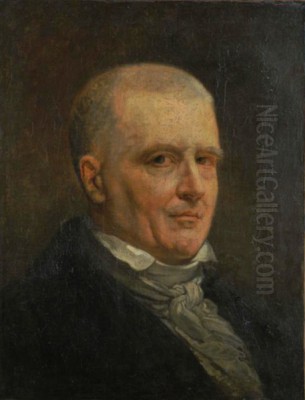
Jean-Honoré Fragonard stands as one of the most emblematic figures of the French Rococo period, an era characterized by its lightness, elegance, and celebration of aristocratic life. Active during the twilight years of the Ancien Régime, Fragonard's canvases shimmer with a unique blend of sensuousness, playfulness, and technical brilliance. His work captures the fleeting moments of pleasure, intimacy, and romance that defined the aesthetic sensibilities of his time. Born in Grasse on April 5, 1732, and passing away in Paris on August 22, 1806, Fragonard's life spanned a period of immense social and artistic transformation, witnessing both the zenith of Rococo exuberance and its eventual decline in the face of Neoclassical austerity and revolutionary upheaval. He remains celebrated as perhaps the last great master of the Rococo style, leaving behind a legacy of enchanting paintings that continue to captivate audiences with their charm and vitality.
Early Life and Artistic Awakening
Born in the southern French town of Grasse, known for its perfume industry, Jean-Honoré Fragonard came from a modest background. His father was involved in the trade as a glover and perfume merchant, while his mother was the daughter of a baker. Seeking better opportunities, the family relocated to Paris around 1738 when Jean-Honoré was still a young boy. Initially, his path seemed destined for a more conventional career, as he was briefly apprenticed to a lawyer, a profession far removed from the artistic world he would eventually inhabit.
However, the young Fragonard's true passion lay elsewhere. His inclination towards art quickly became apparent, leading him to abandon his legal studies. His mother, recognizing his talent, sought guidance from one of the era's leading painters. This led him first, albeit briefly, to the studio of Jean-Baptiste-Siméon Chardin. Chardin, a master of still life and quiet domestic scenes, known for his meticulous technique and subtle observation, provided Fragonard with foundational training. Under Chardin, he likely learned the basics of paint mixing, composition, and the patient rendering of form and texture, though Chardin reportedly found the young Fragonard lacked the necessary patience for his methodical approach.
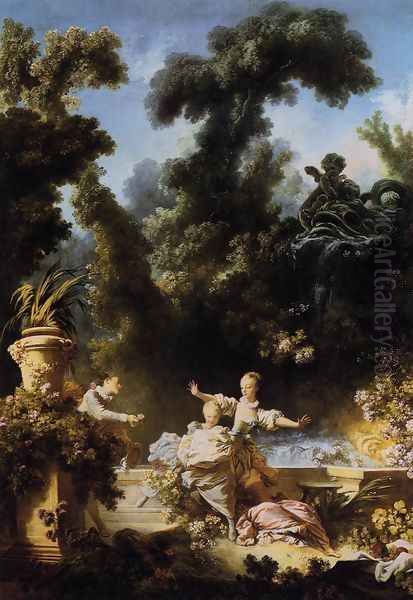
Recognizing that Fragonard's temperament and burgeoning style might be better suited to a different master, Chardin directed him towards the studio of François Boucher. This move proved pivotal. Boucher was the preeminent Rococo painter of the time, favored by King Louis XV and his influential mistress, Madame de Pompadour. Boucher's world was one of mythological fantasies, pastoral scenes, and sensuous nudes, all rendered with a dazzling palette and fluid brushwork. Fragonard thrived in this environment, quickly absorbing his master's style and techniques. His ability to emulate Boucher was so remarkable that some of his early works were, for a time, difficult to distinguish from those of his celebrated teacher. Boucher's influence profoundly shaped Fragonard's artistic development, instilling in him the lightness of touch, decorative sensibility, and thematic focus on pleasure and romance that would define his career.
The Path to Mastery: Apprenticeship and the Prix de Rome
Fragonard's time in François Boucher's studio was transformative. Boucher, recognizing the young artist's prodigious talent and rapid progress, became a crucial mentor. Under Boucher's tutelage, Fragonard honed his skills, mastering the fluid brushwork, delicate color harmonies, and charming subject matter characteristic of the high Rococo style. He learned to depict rosy-cheeked cherubs, playful mythological figures, and idyllic pastoral scenes with an effortless grace that mirrored his master's own popular works. This period was essential in shaping Fragonard's artistic identity, even as he began to develop his own unique variations on the Rococo aesthetic.
Boucher encouraged Fragonard to compete for the prestigious Prix de Rome, an award granted by the French Royal Academy of Painting and Sculpture that funded a period of study in Italy. Despite not being a formal student of the Academy himself at that point, Fragonard entered the competition. In 1752, he achieved a remarkable success, winning the prize with his historical painting, Jeroboam Sacrificing to the Idols. This victory was a significant milestone, validating his talent and opening the door to further academic training and the invaluable experience of studying the Italian masters firsthand.
Before departing for Rome, Fragonard spent some time studying under another prominent academician, Charles-André van Loo, who was also a highly respected history painter and First Painter to the King. This brief period, likely between winning the prize and leaving for Italy, would have further grounded him in the more formal traditions of academic painting, complementing the decorative flair he had absorbed from Boucher. Winning the Prix de Rome and the subsequent training marked Fragonard's official entry into the established art world of his time, setting the stage for his formative years in Italy.
Italian Horizons: Influence and Friendship
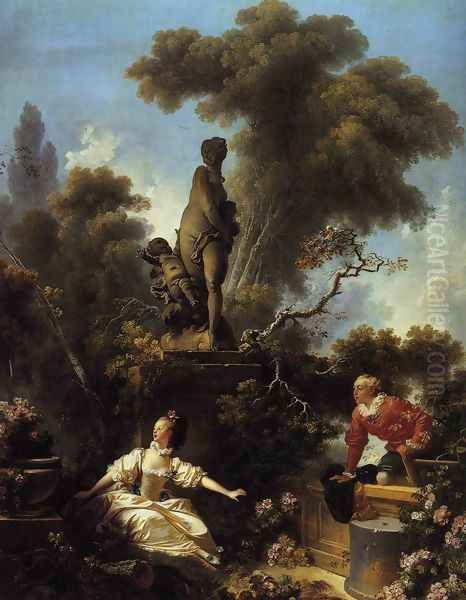
The journey to Italy, funded by the Prix de Rome, was a crucial period in Fragonard's artistic formation, lasting from 1756 to 1761. Residing at the French Academy in Rome, he was immersed in the art of the Italian Renaissance and Baroque masters. While initially perhaps overwhelmed by the monumental works of Michelangelo and Raphael, he found greater inspiration in the more painterly and dynamic styles of Baroque artists. He was particularly drawn to the vibrant colors, dramatic compositions, and energetic brushwork of Venetian painters like Giovanni Battista Tiepolo, whose frescoes displayed a lightness and theatricality that resonated with Fragonard's own developing sensibilities. The rich traditions of Roman and Neapolitan Baroque, including artists like Pietro da Cortona and Luca Giordano, also likely left their mark, encouraging a bolder handling of paint and composition.
During his time in Italy, Fragonard formed significant friendships that profoundly influenced his work. Most notably, he developed a close bond with fellow artist Hubert Robert. Robert, who specialized in painting picturesque landscapes and romanticized ruins, became Fragonard's frequent sketching companion. Together, they explored Rome and its surrounding countryside, drawing ancient monuments, gardens, and scenic vistas. This collaboration stimulated Fragonard's interest in landscape painting, encouraging him to capture the effects of light and atmosphere with a new immediacy, often using red chalk, a medium he mastered with exceptional skill.
Another important figure during his Italian stay was the Abbé de Saint-Non, a wealthy art enthusiast, amateur engraver, and patron. Saint-Non invited Fragonard and Robert to stay with him at the Villa d'Este in Tivoli during the summer of 1760. The villa's spectacular gardens, with their cascading fountains, ancient cypresses, and dramatic views, provided endless inspiration. Fragonard produced numerous brilliant red chalk drawings during this period, capturing the lush beauty and romantic atmosphere of the location. Saint-Non later commissioned Fragonard to create drawings based on Italian masterpieces for his publication, Voyage pittoresque ou Description des Royaumes de Naples et de Sicile. This Italian sojourn not only exposed Fragonard to seminal artworks but also fostered key relationships and directed his attention towards landscape and drawing, diversifying his artistic practice beyond the purely decorative style inherited from Boucher.
Return to Paris and Academic Recognition
Upon returning to Paris in 1761, Fragonard initially sought to establish himself within the formal structure of the Royal Academy. To gain official recognition, aspiring members were required to submit a reception piece, typically a large-scale history painting demonstrating their mastery of composition, anatomy, and elevated subject matter. Fragonard worked diligently on his submission, Coresus and Callirrhoe, a dramatic scene drawn from classical mythology depicting a high priest sacrificing himself to save his beloved.
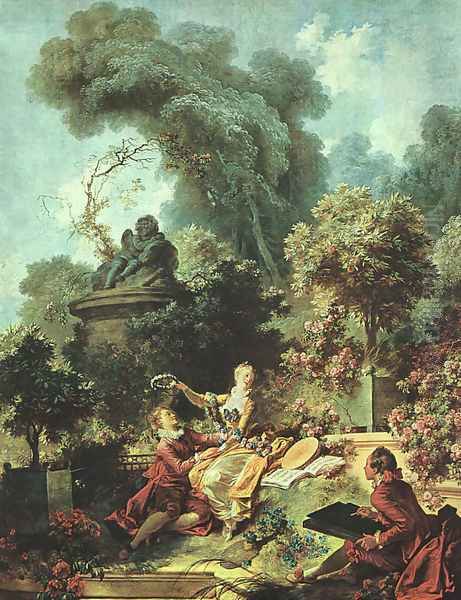
Presented to the Academy in 1765, Coresus and Callirrhoe was a resounding success. The painting was lauded by critics, including the influential Denis Diderot, and purchased for the Crown by King Louis XV, intended to be reproduced as a tapestry by the Gobelins manufactory. This triumph secured Fragonard's admission into the Academy as a history painter, seemingly setting him on a path towards prestigious royal commissions and a career focused on grand, serious subjects. It appeared he was poised to follow the traditional route to artistic eminence within the academic system.
However, despite this initial success in the historical genre, Fragonard soon pivoted away from large-scale public commissions. He found the demands and constraints of official history painting less suited to his temperament than the lighter, more intimate subjects favored by private collectors. The lucrative market for smaller paintings depicting scenes of love, leisure, and playful encounters – the hallmarks of the Rococo style he had mastered under Boucher – proved more appealing and financially rewarding. Consequently, Fragonard increasingly dedicated his talents to serving a clientele of wealthy financiers, aristocrats, and courtiers who desired works that were charming, decorative, and often carried subtle erotic undertones. This shift marked a departure from the academic career path his reception piece suggested, leading him towards the style and subjects for which he is most famous today.
The Essence of Fragonard: Style and Themes
Jean-Honoré Fragonard's mature style is synonymous with the late Rococo movement, yet it possesses a distinctiveness that sets it apart. His art is characterized by an extraordinary dynamism, a vibrant palette, and a remarkably fluid, almost spontaneous brushwork. He often employed techniques like alla prima (wet-on-wet painting), which contributed to the freshness and immediacy of his canvases. His handling of paint could range from delicate, feathery strokes in intimate scenes to bold, vigorous applications in his more expressive works, such as the famous Figures de fantaisie (Fantasy Figures). Light plays a crucial role, often dappled or dramatically focused, enhancing the mood and highlighting textures, from shimmering silks to lush foliage.
Thematically, Fragonard explored the realms of love, pleasure, nature, and intimacy. He inherited the tradition of the fête galante – scenes of elegant figures enjoying themselves outdoors – from Antoine Watteau, but infused it with a greater sense of energy and often a more overt sensuality. His canvases frequently depict clandestine meetings, playful pursuits, stolen kisses, and moments of romantic abandon, set within idealized landscapes or luxurious interiors. These scenes, while lighthearted, often contain subtle narratives and symbolic elements related to courtship, desire, and the fleeting nature of pleasure.
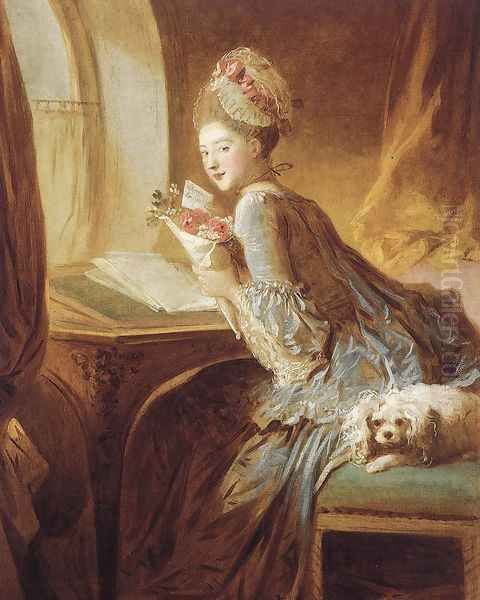
Beyond amorous encounters, Fragonard also excelled in depicting domestic intimacy and the joys of family life, particularly after his marriage to Marie-Anne Gérard in 1769. His portraits, especially those of children and his so-called Fantasy Figures, showcase his ability to capture personality and fleeting expressions with remarkable speed and insight. Landscape painting, nurtured during his time in Italy, remained an important genre for him. His landscapes, whether real or imagined, are typically lush, atmospheric, and imbued with a sense of romanticism, often serving as evocative backdrops for human activity. Fragonard's unique blend of technical virtuosity, thematic focus on pleasure, and ability to convey movement and emotion makes his work the quintessential expression of Rococo grace and vitality.
Iconic Canvases: Defining Works
Fragonard's oeuvre is rich with memorable paintings, but several stand out as defining masterpieces that encapsulate his style and the spirit of his era. Perhaps the most famous is The Swing (L'Escarpolette), painted around 1767. Commissioned by the Baron de Saint-Julien for his mistress, the painting depicts a young woman on a swing, propelled by an older man (likely her husband or chaperone) hidden in the shadows, while her young lover reclines in the bushes below, perfectly positioned to glimpse up her skirts as her shoe flies off. Set in a lush, overgrown garden, the scene is a confection of shimmering fabrics, dappled light, and playful eroticism. It remains the ultimate icon of Rococo frivolity and intrigue.
Another significant commission was The Progress of Love (Les Progrès de l'amour dans le cœur d'une jeune fille), a series of four large canvases commissioned around 1771 by Madame du Barry, King Louis XV's official mistress, for her new pavilion at Louveciennes. The paintings depict stages of a courtship: The Pursuit, The Meeting, The Lover Crowned, and Love Letters. These works are masterpieces of decorative painting, filled with swirling movement, lush landscapes, and romantic figures. However, shortly after their installation, Madame du Barry rejected them, possibly finding their exuberant Rococo style already outdated compared to the emerging Neoclassical taste. Fragonard took the paintings back, later adding further panels. The series eventually found a home in his cousin's house in Grasse.
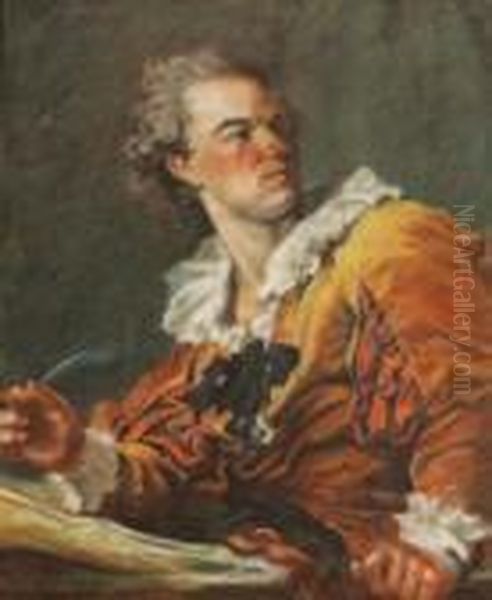
Fragonard's Figures de fantaisie (Fantasy Figures), painted rapidly in the late 1760s and early 1770s, represent a different facet of his genius. These bust-length portraits, often depicting friends or acquaintances in extravagant costumes, are characterized by their incredibly bold and energetic brushwork, seemingly executed in a single session. Works like Young Girl Reading (La Liseuse), though sometimes debated whether it belongs to this series stylistically, share a similar sense of immediacy and focus on an absorbed individual. These paintings showcase Fragonard's technical bravura and his interest in capturing fleeting moments and expressions. Other notable works like The Stolen Kiss, Blind Man's Bluff, and numerous intimate genre scenes and evocative landscapes further cement his reputation as a versatile and captivating painter of Rococo life.
A Circle of Artists and Patrons
Fragonard's career unfolded within a vibrant network of fellow artists, patrons, and family members who influenced his life and work. His early training placed him in the orbit of the leading figures of the French art world, Jean-Baptiste-Siméon Chardin and François Boucher. While Chardin provided foundational skills, Boucher's studio was the crucible where Fragonard's Rococo style was forged. His relationship with Boucher remained significant, even as Fragonard developed his own independent artistic voice.
His time in Italy fostered crucial friendships, particularly with the landscape painter Hubert Robert. Their shared experiences sketching ruins and gardens left a lasting impact on both artists' approaches to landscape. The patronage of the Abbé de Saint-Non during this period was also vital, providing support and opportunities. Back in Paris, Fragonard cultivated relationships with a wide circle of private patrons – financiers, aristocrats, and members of the royal court like Madame du Barry – who eagerly commissioned his charming and often risqué paintings. These patrons preferred his lighter subjects over the grand history paintings favored by the Academy, steering his career towards the private market.
Family played a significant role in Fragonard's later artistic life. In 1769, he married Marie-Anne Gérard, herself a painter specializing in miniatures. Her younger sister, Marguerite Gérard, came to live with them around 1775 and became Fragonard's student and collaborator. Marguerite developed a successful career in her own right, painting detailed genre scenes that sometimes echoed Fragonard's themes but possessed a distinct, more polished style influenced by Dutch Golden Age painters like Gabriel Metsu and Gerard ter Borch. Some works from Fragonard's later period are thought to be collaborations between him and Marguerite.
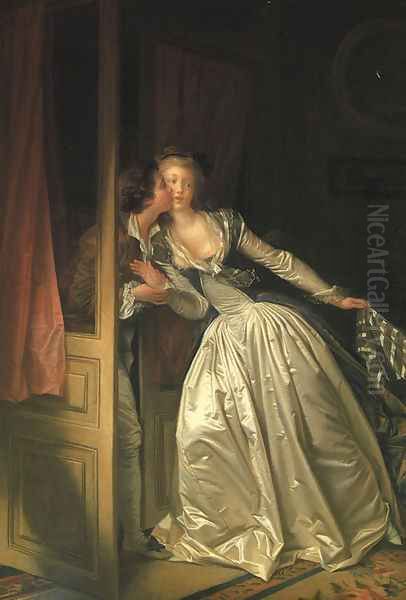
Interestingly, Fragonard maintained a cordial relationship with Jacques-Louis David, the leading figure of the Neoclassical movement that would eventually eclipse Rococo. Despite their vastly different artistic styles and philosophies, David respected Fragonard and later used his influence during the French Revolution to help the older artist secure a position at the Louvre Museum, demonstrating a personal connection that transcended artistic rivalry. This network of teachers, friends, patrons, and family shaped the trajectory of Fragonard's career and the environment in which his art flourished.
Changing Tides: The Revolution and Later Life
The latter part of Fragonard's career coincided with a significant shift in artistic tastes and the tumultuous events of the French Revolution. The lighthearted, pleasure-oriented themes of Rococo began to fall out of favor, replaced by the Neoclassical style championed by Jacques-Louis David. Neoclassicism, with its emphasis on rationality, morality, classical antiquity, and civic virtue, resonated more strongly with the Enlightenment ideals and the revolutionary spirit brewing in France. Patrons increasingly preferred David's stern historical narratives and Greuze's moralizing genre scenes over Fragonard's depictions of aristocratic leisure and amorous pursuits.
The French Revolution, beginning in 1789, had a devastating impact on Fragonard's livelihood. His primary clientele consisted of the aristocracy and wealthy financiers, many of whom were imprisoned, executed, or forced into exile during the Reign of Terror. The market for his style of painting evaporated almost overnight. His patrons disappeared, and the demand for Rococo luxury vanished amidst the political and social upheaval. Fragonard found himself financially insecure and artistically marginalized.
During this difficult period, his friend Jacques-Louis David, despite being a key figure in the Revolution and the proponent of the rival Neoclassical style, intervened on Fragonard's behalf. David helped secure Fragonard administrative positions, including a role on the Arts Commission and later as a curator at the newly formed Muséum Central des Arts de la République, which would become the Louvre Museum. This provided some measure of stability, though Fragonard's creative output significantly diminished.
He spent some time away from the turmoil of Paris, finding refuge at his cousin's house in Grasse, where he brought the panels of The Progress of Love. He eventually returned to Paris but struggled to adapt to the new artistic climate. His style was seen as irrevocably linked to the frivolous and decadent Ancien Régime that the Revolution had overthrown. He lived his final years in relative obscurity and poverty, his vibrant Rococo world having faded into history.
Rediscovery and Enduring Legacy
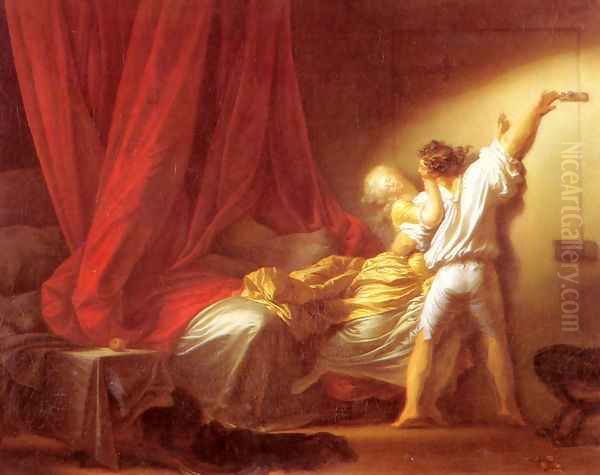
Jean-Honoré Fragonard died in Paris on August 22, 1806, largely forgotten by the art world. The Neoclassical and subsequent Romantic movements dominated the early 19th century, and Fragonard's Rococo style was dismissed as superficial and outdated, associated with the perceived moral failings of the aristocracy. For several decades, his work remained in obscurity, appreciated only by a small number of collectors.
However, a revival of interest in 18th-century French art began in the mid-to-late 19th century. Critics and collectors, notably the Goncourt brothers (Edmond and Jules), played a crucial role in rehabilitating Fragonard's reputation. They praised his technical skill, his charm, and his ability to capture the spirit of his age. This reassessment coincided with the rise of Impressionism, and artists began to look anew at Fragonard's work, finding affinities with his painterly approach.
Fragonard's influence, though perhaps indirect, can be seen in the work of certain Impressionist painters. His loose, visible brushwork, his interest in capturing fleeting effects of light, and his focus on scenes of leisure and everyday life prefigure aspects of the Impressionist aesthetic. Artists like Pierre-Auguste Renoir, with his sensuous figures and dappled light, and Berthe Morisot (who was, in fact, Fragonard's grand-niece), with her intimate portrayals of women and children, seem to share a certain sensibility with their Rococo predecessor. Some critics have even gone so far as to call Fragonard a precursor to Impressionism, recognizing his innovative handling of paint and light.
Today, Fragonard is firmly established as one of the great masters of French painting. His works are highly sought after and are housed in major museums worldwide, including the Louvre in Paris, the Wallace Collection in London, the Metropolitan Museum of Art in New York, and the National Gallery of Art in Washington, D.C. He is celebrated not only as a quintessential Rococo artist but also as a painter of extraordinary technical virtuosity and enduring charm, whose work continues to evoke the ephemeral grace and sensuous delight of a bygone era.
Conclusion: The Last Sparkle of Rococo
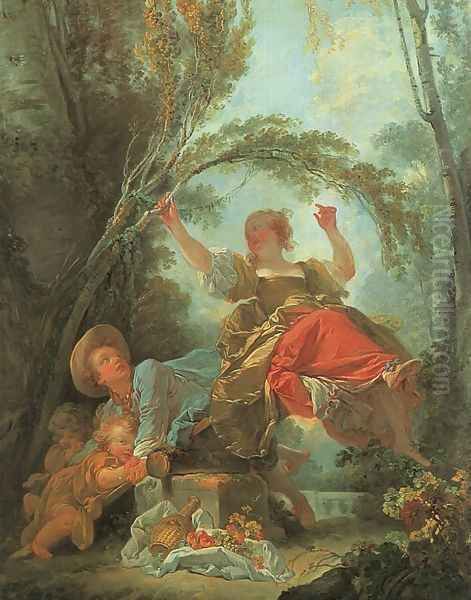
Jean-Honoré Fragonard remains an indispensable figure in the history of art, embodying the final, brilliant flourishing of the Rococo style in France. His canvases, alive with movement, light, and color, capture the essence of an era dedicated to elegance, pleasure, and intimacy. From the playful eroticism of The Swing to the tender domesticity of his family scenes and the dazzling spontaneity of his Fantasy Figures, Fragonard demonstrated remarkable versatility and technical mastery. His fluid brushwork and keen observation of human emotion lent a unique vitality to his work, setting him apart even within the accomplished context of 18th-century French painting.
Though his popularity waned dramatically with the rise of Neoclassicism and the upheaval of the French Revolution, Fragonard's art experienced a well-deserved resurgence in the later 19th century. His painterly freedom and focus on light found resonance with new generations of artists, particularly the Impressionists, securing his place as not just a master of a past style but also as an artist whose innovations looked towards the future. Today, Fragonard's paintings are cherished for their charm, their technical brilliance, and their evocative portrayal of the fleeting pleasures of life, offering a captivating window onto the twilight world of the French Ancien Régime. He stands as a testament to the enduring power of grace, beauty, and joie de vivre in art.